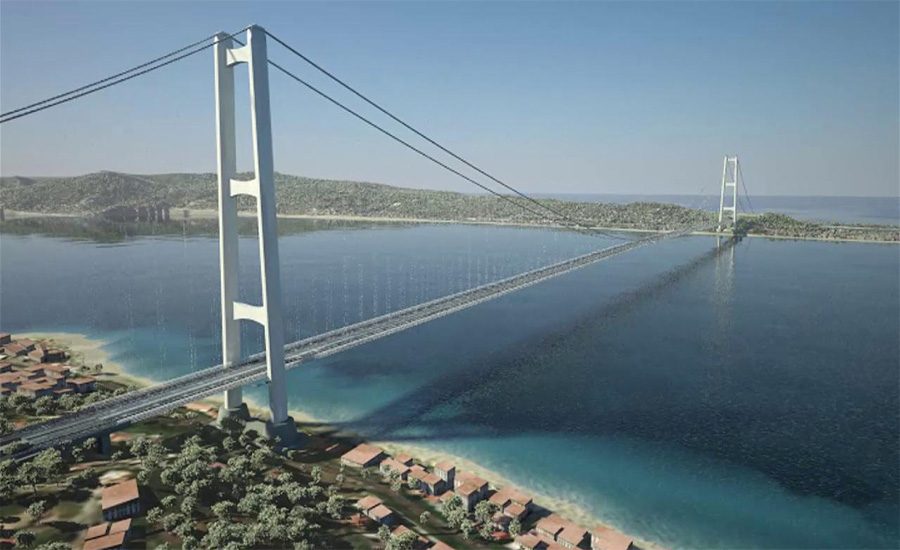Italy Revives Planned $15.7B Messina Crossing

UPDATED 10:04 AM EDT, August 11, 2025
Plans to build what would be the world’s longest suspension bridge—with a 3,300-meter-long main span—are moving forward. Italy’s Interministerial Committee for Economic Planning and Sustainable Development on Aug. 6 approved the definitive design and full public financing for the Strait of Messina Bridge, a $15.7- billion project that would link Sicily and Calabria.
Transport Vice Premier Matteo Salvini said the vote “puts the project irreversibly on track,” a phrase he first used during a technical briefing in February 2023, according to the news site StrettoWeb.
RELATED
Italy Revives Plan for World’s Longest Suspension Bridge
The CIPESS resolution, to be published in the Gazzetta Ufficiale in the coming weeks, earmarks annual appropriations through 2034 and reactivates a lump-sum, design–build contract now valued at $12.3 billion held by the Eurolink consortium led by Milan-based contractor Webuild S.p.A. Preliminary tasks—geotechnical borings, archaeological surveys and rights of way acquisitions —may begin once Italy’s Court of Auditors completes its statutory review, a step that typically takes “a few weeks,” Salvini told reporters.
Design and Scope
The suspension-bridge engineering is being led by Danish consultant COWI A/S, retained from earlier design phases and known for its work on Denmark’s Great Belt and Turkey’s 1915 Çanakkale spans.
“The Italian government’s decision to move forward represents a very exciting step, and together with our partner, Eurolink (Webuild-led consortium), and leading international experts, we are ready at the starting line, preparing to contribute our expertise as soon as the final approvals are in place,” Jens Højgaard Christoffersen, COWI CEO, said in a statement.
Project documents filed with concessionaire Stretto di Messina describe a 3,666-meter crossing whose 3,300-m main suspended span would eclipse Turkey’s 2,023-m 1915 Çanakkale Bridge and Japan’s 1,991-meter Akashi-Kaikyo Bridge. Four 1.26-m-dia cables, each made up of 44,323 high-strength steel wires, will support a 60-m-wide steel deck designed to carry six highway lanes, two rail tracks and service walkways, giving the structure a capacity of 6,000 vehicles an hour and 200 trains a day.
Italian media outlet Sky TG24 reports that wind-tunnel testing at Milan Polytechnic and other laboratories found the deck aerodynamically stable in gusts up to 292 km/h, while seismic design parameters exceed Italian code minimums for the Calabrian fault zone. The navigational clearance for shipping is 72 m over a 600-m channel.
Roughly 40% of the overall budget covers the bridge itself; the balance funds more than 40 km of road and rail approaches, three underground stations in Messina and a logistics hub on the Calabrian shore.
Webuild targets early 2026 for construction, with a projected opening in 2032. Before superstructure work can begin, the project must satisfy 62 conditions attached to the environmental-impact decree issued by Italy’s VIA/VAS commission in November 2024. Those prescriptions range from expanded habitat restoration to fatigue testing of the main cables.
On Aug. 4 a coalition of Greenpeace, Italy’s Legambiente environmental association, Lipu bird-protection charity and World Wildlife Fund filed a new complaint with the European Union, alleging several requirements remain unmet, Legambiente said in a statement.
Anti-corruption officials are also finalizing an updated “protocollo di legalità” to guard against mafia infiltration—a prerequisite for Court of Auditors clearance, according to the national anti-corruption agency ANAC. CIPESS has directed the Transport Ministry to issue quarterly cost-tracking reports once construction starts.
Webuild forecasts an average on-site workforce of 4,300, peaking at 7,000, and estimates the project will support more than 100,000 jobs across the Italian supply chain. Supporters argue the bridge will plug Sicily into Europe’s high-speed-rail network, creating a continuous Berlin-to-Palermo corridor within the European Union Trans-European Transport Network. Critics say earthquake risk, sensitive marine habitats and potential cost overruns still pose significant challenges.
The post "Italy Revives Planned $15.7B Messina Crossing" appeared first on Consulting-Specifying Engineer

